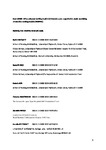How COVID-19 has affected staffing models in intensive care: a qualitative study examining alternative staffing models (SEISMIC)
| dc.contributor.author | Endacott, Ruth | |
| dc.contributor.author | pearce, susie | |
| dc.contributor.author | Rae, Pamela | |
| dc.contributor.author | Richardson, A | |
| dc.contributor.author | Bench, S | |
| dc.contributor.author | Pattison, N | |
| dc.date.accessioned | 2021-10-11T15:16:33Z | |
| dc.date.issued | 2021-11-15 | |
| dc.identifier.issn | 0309-2402 | |
| dc.identifier.issn | 1365-2648 | |
| dc.identifier.uri | http://hdl.handle.net/10026.1/18035 | |
| dc.description.abstract |
<jats:title>Abstract</jats:title><jats:sec><jats:title>Aims</jats:title><jats:p>To understand how COVID‐19 affected nurse staffing in intensive care units (ICUs) in England, and to identify factors that influenced, and were influenced by, pandemic staffing models.</jats:p></jats:sec><jats:sec><jats:title>Design</jats:title><jats:p>Exploratory qualitative study.</jats:p></jats:sec><jats:sec><jats:title>Methods</jats:title><jats:p>Semi‐structured, online interviews conducted July–September 2020 with regional critical care leaders including policy leads (<jats:italic>n</jats:italic> = 4) and directors/lead nurses (<jats:italic>n</jats:italic> = 10) across critical care networks in England.</jats:p></jats:sec><jats:sec><jats:title>Findings</jats:title><jats:p>The six themes emerging from the framework analysis illustrate how the pre‐pandemic ICU culture influenced ICU staffing models during the pandemic. Changes in staffing impacted on the workforce and the care delivered, whilst it was necessary to learn from, and adjust to, a rapidly changing situation. Variation across and between networks necessitated variation in responses. The overwhelming outcome was that the pandemic has challenged the central tenets of ICU nurse staffing.</jats:p></jats:sec><jats:sec><jats:title>Conclusions</jats:title><jats:p>Pandemic nurse staffing models resulted in changes to ICU skill‐mix and staffing numbers. Factors such as the impact of nurse staffing on care practices and on the workforce need to be taken into account when developing and testing future nurse staffing models for ICU. The extent to which ICUs will return to former staffing models is not yet known but there seems to be an appetite for change.</jats:p></jats:sec><jats:sec><jats:title>Impact</jats:title><jats:p>In common with many countries, nurse staffing in English ICUs was adapted to address surge requirements during the COVID‐19 pandemic. Findings highlight the challenge COVID‐19 presented to pre‐pandemic ICU nurse staffing guidelines, the impact on patient and staff well‐being and the potential legacy for future staffing models. Study findings have implications for ICU nurse managers, researchers and policy makers: nurse staffing models need to be adaptable to the local context of care and future research should investigate the impact of different models on patients, staff and health service outcomes.</jats:p></jats:sec> | |
| dc.format.extent | 1075-1088 | |
| dc.format.medium | Print-Electronic | |
| dc.language | en | |
| dc.language.iso | en | |
| dc.publisher | Wiley | |
| dc.subject | COVID-19 | |
| dc.subject | intensive care | |
| dc.subject | nurses | |
| dc.subject | nursing workforce | |
| dc.subject | qualitative | |
| dc.title | How COVID-19 has affected staffing models in intensive care: a qualitative study examining alternative staffing models (SEISMIC) | |
| dc.type | journal-article | |
| dc.type | Journal Article | |
| plymouth.author-url | https://www.webofscience.com/api/gateway?GWVersion=2&SrcApp=PARTNER_APP&SrcAuth=LinksAMR&KeyUT=WOS:000718387300001&DestLinkType=FullRecord&DestApp=ALL_WOS&UsrCustomerID=11bb513d99f797142bcfeffcc58ea008 | |
| plymouth.issue | 4 | |
| plymouth.volume | 78 | |
| plymouth.publication-status | Published | |
| plymouth.journal | Journal of Advanced Nursing | |
| dc.identifier.doi | 10.1111/jan.15081 | |
| plymouth.organisational-group | /Plymouth | |
| plymouth.organisational-group | /Plymouth/Faculty of Health | |
| plymouth.organisational-group | /Plymouth/Faculty of Health/School of Nursing and Midwifery | |
| plymouth.organisational-group | /Plymouth/REF 2021 Researchers by UoA | |
| plymouth.organisational-group | /Plymouth/REF 2021 Researchers by UoA/UoA03 Allied Health Professions, Dentistry, Nursing and Pharmacy | |
| plymouth.organisational-group | /Plymouth/Research Groups | |
| plymouth.organisational-group | /Plymouth/Research Groups/Institute of Health and Community | |
| plymouth.organisational-group | /Plymouth/Research Groups/Plymouth Institute of Health and Care Research (PIHR) | |
| plymouth.organisational-group | /Plymouth/Users by role | |
| plymouth.organisational-group | /Plymouth/Users by role/Academics | |
| dc.publisher.place | England | |
| dcterms.dateAccepted | 2021-09-26 | |
| dc.rights.embargodate | 2022-11-15 | |
| dc.identifier.eissn | 1365-2648 | |
| dc.rights.embargoperiod | Not known | |
| rioxxterms.versionofrecord | 10.1111/jan.15081 | |
| rioxxterms.licenseref.uri | http://www.rioxx.net/licenses/all-rights-reserved | |
| rioxxterms.licenseref.startdate | 2021-11-15 | |
| rioxxterms.type | Journal Article/Review | |
| plymouth.funder | Safe staffing in intensive care: implementation of a new model::National Institute of Health Research |


